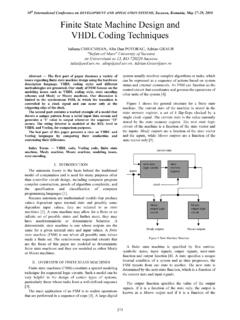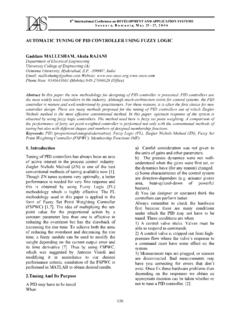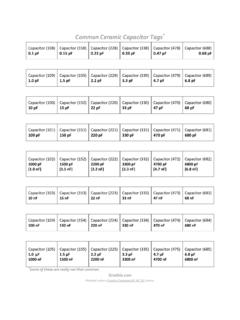Transcription of LIVESTOCK RF IDENTIFICATION AND MANAGEMENT – PART …
1 95 7th International Conference on DEVELOPMENT AND APPLICATION SYSTEMS S u c e a v a, R o m a n i a, M a y 27 29, 2 0 0 4 LIVESTOCK RF IDENTIFICATION AND MANAGEMENT PART I: 13,56 MHz RFID SYSTEM Valentin POPA, Toader STRUGARIU, Catalin SIICU, Eugen COCA "Stefan cel Mare" University of Suceava , RO-720225 Suceava Abstract. This paper is proposing a new 13,56 MHz RFID transponder based system for animal IDENTIFICATION and tracking. The present barcode and 125/134 kHz transponder based systems are presented and compared with the performances of the new 13,56 MHz RFID system. The paper underlines the mainly benefits for the new system: read/write procedures, larger operating range and shorter read/write time.
2 The special transponder coil label attached to the animal s tag is designed. A MANAGEMENT program for LIVESTOCK IDENTIFICATION and tracking will be presented in the part II of this paper. Keywords: transponder, LIVESTOCK , RFID, MANAGEMENT , IDENTIFICATION , tracking, animal. 1. Introduction The legislative and procedure harmonization in the veterinary and zootehnic fields between Romania and European Union represents one of the major criteria for integration in the European structures, in agriculture domain. LIVESTOCK IDENTIFICATION , registration and animal origin recording become few very important activities in order to manage the zootehnic sector, animal tracking and their health.
3 According with all these goals, the government issued few specific laws for cattle, sheep, hogs or horses IDENTIFICATION and the in-field recording and the traceability tracking process started already. The most implemented electronic IDENTIFICATION systems in LIVESTOCK area are barcode systems and Radio Frequency IDENTIFICATION (RFID) systems [1]. Electronic IDENTIFICATION systems for animals have been used for almost 20 years in USA and Australia and are now state of the art in Europe. Nowadays, these systems are used for tracing the origin of animals, for the control of epidemics, diseases and treatments applied to the animal, for automatic feeding and productivity calculating in modern farms, etc.
4 The barcode system is based on a printed binary code comprising a field of bars and gaps, arranged in a parallel configuration representing data. An optical laser scanner reads this bars and gaps configuration. In a RFID system, data is stored on an electronic data-carrying device the transponder. The transponder is functioning by replying to an interrogation request received from a reader, mainly by returning some data stored in the transponder memory such as an identity code or the value of a measurement. In Romania, the electronic IDENTIFICATION and tracking systems started to be implemented since 2003 for a limited number of applications (access control, items and persons IDENTIFICATION ).
5 In the zootehnic field, for cattle, sheep and hogs IDENTIFICATION , a barcode based system is proposed. For example, in cattle case, a tag with a barcode ID number will permanently be mounted in the ear of the animal. On the other hand, a special injectable transponder based tag is proposed for horse IDENTIFICATION . Basing on the present barcode based system, this paper will introduce a 13,54 MHz RFID system in order to improve the LIVESTOCK IDENTIFICATION and MANAGEMENT . The new system will not exclude the former one but it will improve it, working together. 2. RFID systems A RFID system is always made up of two components: the transponder and the interrogator or reader.
6 The block diagram for a RFID system is depicted in figure 1. The 96 equipment usually named reader can be a read or even a read/write device, depending upon the design and technology. The transponder is composed by a chip transponder and an antenna circuit (a coil L and an equivalent capacitor C). The equivalent capacitor C can be an internal capacitor (realised on the same chip with the transponder chip), an external capacitor or a combination between these two variants. In all variants, the designer will include in C the parasitic capacitance also. All transponder functions are under reader control. The transponders used in IDENTIFICATION systems are usually classified depending of the coupling type between reader and transponder.
7 There are inductively coupled, electrically coupled and electro-magnetically coupled transponders. The inductively (magnetic) coupled transponders, also classified in proximity and vicinity transponders, are still the most common transponders available today on the RFID market [2]. Generally they are operating at frequencies typically in the order of 125/134 kHz for proximity transponders and 13,56 MHz for vicinity transponders. These transponders are characterised by antenna systems that comprise of numerous turns of a fine wire around a coil former to collect energy from reader's electromagnetic field, using the magnetic component.
8 Due to the magnetic method of coupling, range is limited generally to 1-2 cm for proximity transponders and up to 25 cm for vicinity transponders. However, the maximum range reported by producers is around 2 m, using a high gain reader antenna and only for 13,56 MHz transponders. The 125/134 kHz inductively coupled transponders are still the only transponders used in LIVESTOCK electronic IDENTIFICATION systems nowadays. L Figure 1. The block diagram for a RFID system Digital control unit (microcontroller) RF block Power supply unit Reader antenna Chip transponder C Reader TransponderAntenna circuitElectric field coupled transponders [3] generally provide vastly increased ranges over their magnetic counterparts.
9 Efficient electric field propagation requires antenna systems that are typically half a wavelength of the operating frequency in size. This causes practical limits for the lowest frequency due to the size of the antenna. Higher operating frequencies require more expensive components and loose the ability to transfer energy at a rate of the inverse of the wavelength squared. In addition, the energy density of a signal radiated using electric field coupling, decreases as the inverse of the distance squared between the source and the transponder. Whereas sensitive receivers can compensate for this loss of energy for the data communications over long distances, passive transponders which use the reader's energising field as a source of power are practically limited to about ten meters.
10 One very important feature of RFID systems is the power supply to the transponder. Passive transponders do not have their own power supply. The whole required power for operation must be drawn from the electromagnetic field of the reader. Both components, electric and magnetic, could be used by transponder. Active transponders incorporate a battery, which supplies a part of the power for operation (generally for microcontroller operation only, but not for data transmission via electromagnetic field for which the reader electromagnetic field is still used). In the simplest and the cheapest variant, the transponder can have only one bit memory and they are mainly used in EAS (Electronic Article Surveillance), in anti-thief systems.













